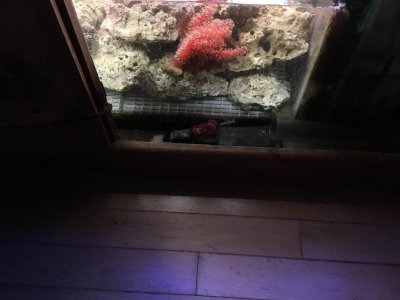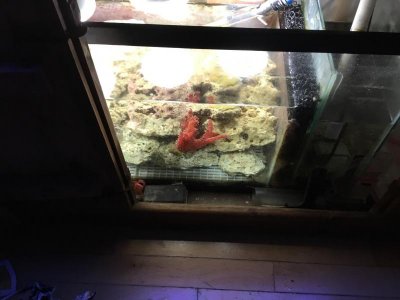You are using an out of date browser. It may not display this or other websites correctly.
You should upgrade or use an alternative browser.
You should upgrade or use an alternative browser.
Red Hot Chilli Pepper
Red Hot Chilli Pepper
Chilli update
After nearly 48hour in cryptic zone refugium, Chilli's color has gone from maroon to a vibrant red, as he was in shipping bag.
Due to continued sand bed maintenance, detritus continues to be stirred up. Not good for Chilli. Chilli stays down under for another week.
Red Hot Chilli Pepper
Chilli update
After nearly 48hour in cryptic zone refugium, Chilli's color has gone from maroon to a vibrant red, as he was in shipping bag.
Due to continued sand bed maintenance, detritus continues to be stirred up. Not good for Chilli. Chilli stays down under for another week.
Attachments
Scrubber_steve
I'm really very likeable
Chilli update
After nearly 48hour in cryptic zone refugium, Chilli's color has gone from maroon to a vibrant red, as he was in shipping bag.
Due to continued sand bed maintenance, detritus continues to be stirred up. Not good for Chilli. Chilli stays down under for another week.
Chilli might think its cool in the cryptic zone & might like to make it his home?
Scrubber_steve
I'm really very likeable
Just started on a cryptic zone sump design.
Have built a permeable dividing wall - semi cryptic/cryptic zones
Made from coral rock, coral gravel, white cement & rocksalt.

Have built a permeable dividing wall - semi cryptic/cryptic zones
Made from coral rock, coral gravel, white cement & rocksalt.
Chilli might think its cool in the cryptic zone & might like to make it his home?
Maybe for a short time of < 3 months. By then my algae feeding platform will have filled in providing the shade that Chilli requires. Also, my sand bed maintenance should be completed eliminating particulates clogging up Chilli's feathers.
Scrubber_steve
I'm really very likeable
Exposed sponges tend to be very distinctive. Its relatively easy to tell the
difference. Unfortunately, most of the sponges that have been historically
offered for sale in the hobby are from exposed zones. These sponges do not
survive well in cryptic habitats. In general, if a sponge grows out of a rock
that is held in a cryptic zone, chances are real good it is a cryptic sponge.
Exposed sponges need strong current flows and some need light. Also, sponges
growing under corals tend to be semi-cryptic.
Hi steve, I've read cmat vol 1 & 2, at least the parts that apply to what I'm attempting to do. I'm using a permeable coral rock dividing wall to seperate a semi cryptic / cryptic zone in my sump. I was planning to slightly illuminate the semi section.
My problem is I have no access to dedicated cryptic sponge rock.
The best I can do is to use some rock from within my display that has sponge life on it to seed the cryptic zone. These sponges get zero direct light, but some indirect illumination. Will these sponges be ok or not?
I don't want tp place them in a cryptic zone only for them to die & possible pollute the system. Should I perhaps just make the sump fully semi cryptic??
cheers
Twin,
I feel that my mud cryptic refugium is semi-cryptic because the whole back of stand is open to air flow and ambient light.
I have also included a 3G chaeto refugium in display tank overflow box. I figure the production of DOC and micro algae, a type of phytoplankton.
“Marine phytoplankton are mainly composed of micro algae known as dinoflagellates and diatoms, though other algae and cynobacteria can be present”.
I feel that my mud cryptic refugium is semi-cryptic because the whole back of stand is open to air flow and ambient light.
I have also included a 3G chaeto refugium in display tank overflow box. I figure the production of DOC and micro algae, a type of phytoplankton.
“Marine phytoplankton are mainly composed of micro algae known as dinoflagellates and diatoms, though other algae and cynobacteria can be present”.
karimwassef
Active member
Day one of taking down the cryptic... its composed of three layers and sits in the middle of my sump.
The topmost layer is the algae zone. It's made of eggcrate and nylon mesh (like used for ATS). The water mostly flows over this zone from end to end
The second layer creates a baffle zone between the algae zone and the deep zone. Again- eggcrate and mesh. This channels any remaining medium flow to the other end but allows some exchange into the lowest zone.
The last layer is made up of 2quart buckets of sand/mud. Two layers of these buckets separated by eggcrate and mesh.
In this lowest zone, water trickles through the surface layers but does so slowly.
Today, I removed the first two zones...
Here's what I found.. fast zones have feather dusters... thousands clumped together to make "rock"...
In the top eggcrate squares, sand collected forming tiny sand beds protected from flow. These had.... tiny sea cucumbers! Less than 3/4" long! They we so small I thought they were sponges.
Lower down ... three kinds of sponges... first white, then yellow, then on the bottom pinkish purple?. These aren't "attractive" sponges. They look like wet napkin paper with holes and striations. Inside and around them are tiny serpent stars..
I haven't gotten to the buckets but here are the pics:
<a href="http://s1062.photobucket.com/user/karimwassef/media/4FE51C9B-B97D-4EA9-A962-6E50A040A804_zpswutoexae.jpg.html" target="_blank"><img src="http://i1062.photobucket.com/albums/t496/karimwassef/4FE51C9B-B97D-4EA9-A962-6E50A040A804_zpswutoexae.jpg" border="0" alt=" photo 4FE51C9B-B97D-4EA9-A962-6E50A040A804_zpswutoexae.jpg"></a>
<a href="http://s1062.photobucket.com/user/karimwassef/media/CFB83A82-1EFF-4D19-A89A-6A70059948BE_zpsu49vqk0z.jpg.html" target="_blank"><img src="http://i1062.photobucket.com/albums/t496/karimwassef/CFB83A82-1EFF-4D19-A89A-6A70059948BE_zpsu49vqk0z.jpg" border="0" alt=" photo CFB83A82-1EFF-4D19-A89A-6A70059948BE_zpsu49vqk0z.jpg"></a>
<a href="http://s1062.photobucket.com/user/karimwassef/media/CA2C89E8-67F3-475A-86F4-2EE58D82D8DA_zpsakodsq0e.jpg.html" target="_blank"><img src="http://i1062.photobucket.com/albums/t496/karimwassef/CA2C89E8-67F3-475A-86F4-2EE58D82D8DA_zpsakodsq0e.jpg" border="0" alt=" photo CA2C89E8-67F3-475A-86F4-2EE58D82D8DA_zpsakodsq0e.jpg"></a>
<a href="http://s1062.photobucket.com/user/karimwassef/media/FB954E77-D3AE-4C73-8847-8C8EE8B15559_zpsrf3xkebp.jpg.html" target="_blank"><img src="http://i1062.photobucket.com/albums/t496/karimwassef/FB954E77-D3AE-4C73-8847-8C8EE8B15559_zpsrf3xkebp.jpg" border="0" alt=" photo FB954E77-D3AE-4C73-8847-8C8EE8B15559_zpsrf3xkebp.jpg"></a>
<a href="http://s1062.photobucket.com/user/karimwassef/media/3CB190DE-9F9E-44DE-9D80-5D4F6976714B_zpsh9kaisho.jpg.html" target="_blank"><img src="http://i1062.photobucket.com/albums/t496/karimwassef/3CB190DE-9F9E-44DE-9D80-5D4F6976714B_zpsh9kaisho.jpg" border="0" alt=" photo 3CB190DE-9F9E-44DE-9D80-5D4F6976714B_zpsh9kaisho.jpg"></a>
<a href="http://s1062.photobucket.com/user/karimwassef/media/C6631907-0CD1-4FFD-9ADC-07B1B5BE8491_zps5n42ix2h.jpg.html" target="_blank"><img src="http://i1062.photobucket.com/albums/t496/karimwassef/C6631907-0CD1-4FFD-9ADC-07B1B5BE8491_zps5n42ix2h.jpg" border="0" alt=" photo C6631907-0CD1-4FFD-9ADC-07B1B5BE8491_zps5n42ix2h.jpg"></a>
<a href="http://s1062.photobucket.com/user/karimwassef/media/5F0C59CB-7DC7-45EB-A848-3E6381C9DA26_zpsufoogrh6.jpg.html" target="_blank"><img src="http://i1062.photobucket.com/albums/t496/karimwassef/5F0C59CB-7DC7-45EB-A848-3E6381C9DA26_zpsufoogrh6.jpg" border="0" alt=" photo 5F0C59CB-7DC7-45EB-A848-3E6381C9DA26_zpsufoogrh6.jpg"></a>
<a href="http://s1062.photobucket.com/user/karimwassef/media/02EB6DE2-5BBC-41FD-9900-00FD29DB892A_zpssuqrgqov.jpg.html" target="_blank"><img src="http://i1062.photobucket.com/albums/t496/karimwassef/02EB6DE2-5BBC-41FD-9900-00FD29DB892A_zpssuqrgqov.jpg" border="0" alt=" photo 02EB6DE2-5BBC-41FD-9900-00FD29DB892A_zpssuqrgqov.jpg"></a>
The topmost layer is the algae zone. It's made of eggcrate and nylon mesh (like used for ATS). The water mostly flows over this zone from end to end
The second layer creates a baffle zone between the algae zone and the deep zone. Again- eggcrate and mesh. This channels any remaining medium flow to the other end but allows some exchange into the lowest zone.
The last layer is made up of 2quart buckets of sand/mud. Two layers of these buckets separated by eggcrate and mesh.
In this lowest zone, water trickles through the surface layers but does so slowly.
Today, I removed the first two zones...
Here's what I found.. fast zones have feather dusters... thousands clumped together to make "rock"...
In the top eggcrate squares, sand collected forming tiny sand beds protected from flow. These had.... tiny sea cucumbers! Less than 3/4" long! They we so small I thought they were sponges.
Lower down ... three kinds of sponges... first white, then yellow, then on the bottom pinkish purple?. These aren't "attractive" sponges. They look like wet napkin paper with holes and striations. Inside and around them are tiny serpent stars..
I haven't gotten to the buckets but here are the pics:
<a href="http://s1062.photobucket.com/user/karimwassef/media/4FE51C9B-B97D-4EA9-A962-6E50A040A804_zpswutoexae.jpg.html" target="_blank"><img src="http://i1062.photobucket.com/albums/t496/karimwassef/4FE51C9B-B97D-4EA9-A962-6E50A040A804_zpswutoexae.jpg" border="0" alt=" photo 4FE51C9B-B97D-4EA9-A962-6E50A040A804_zpswutoexae.jpg"></a>
<a href="http://s1062.photobucket.com/user/karimwassef/media/CFB83A82-1EFF-4D19-A89A-6A70059948BE_zpsu49vqk0z.jpg.html" target="_blank"><img src="http://i1062.photobucket.com/albums/t496/karimwassef/CFB83A82-1EFF-4D19-A89A-6A70059948BE_zpsu49vqk0z.jpg" border="0" alt=" photo CFB83A82-1EFF-4D19-A89A-6A70059948BE_zpsu49vqk0z.jpg"></a>
<a href="http://s1062.photobucket.com/user/karimwassef/media/CA2C89E8-67F3-475A-86F4-2EE58D82D8DA_zpsakodsq0e.jpg.html" target="_blank"><img src="http://i1062.photobucket.com/albums/t496/karimwassef/CA2C89E8-67F3-475A-86F4-2EE58D82D8DA_zpsakodsq0e.jpg" border="0" alt=" photo CA2C89E8-67F3-475A-86F4-2EE58D82D8DA_zpsakodsq0e.jpg"></a>
<a href="http://s1062.photobucket.com/user/karimwassef/media/FB954E77-D3AE-4C73-8847-8C8EE8B15559_zpsrf3xkebp.jpg.html" target="_blank"><img src="http://i1062.photobucket.com/albums/t496/karimwassef/FB954E77-D3AE-4C73-8847-8C8EE8B15559_zpsrf3xkebp.jpg" border="0" alt=" photo FB954E77-D3AE-4C73-8847-8C8EE8B15559_zpsrf3xkebp.jpg"></a>
<a href="http://s1062.photobucket.com/user/karimwassef/media/3CB190DE-9F9E-44DE-9D80-5D4F6976714B_zpsh9kaisho.jpg.html" target="_blank"><img src="http://i1062.photobucket.com/albums/t496/karimwassef/3CB190DE-9F9E-44DE-9D80-5D4F6976714B_zpsh9kaisho.jpg" border="0" alt=" photo 3CB190DE-9F9E-44DE-9D80-5D4F6976714B_zpsh9kaisho.jpg"></a>
<a href="http://s1062.photobucket.com/user/karimwassef/media/C6631907-0CD1-4FFD-9ADC-07B1B5BE8491_zps5n42ix2h.jpg.html" target="_blank"><img src="http://i1062.photobucket.com/albums/t496/karimwassef/C6631907-0CD1-4FFD-9ADC-07B1B5BE8491_zps5n42ix2h.jpg" border="0" alt=" photo C6631907-0CD1-4FFD-9ADC-07B1B5BE8491_zps5n42ix2h.jpg"></a>
<a href="http://s1062.photobucket.com/user/karimwassef/media/5F0C59CB-7DC7-45EB-A848-3E6381C9DA26_zpsufoogrh6.jpg.html" target="_blank"><img src="http://i1062.photobucket.com/albums/t496/karimwassef/5F0C59CB-7DC7-45EB-A848-3E6381C9DA26_zpsufoogrh6.jpg" border="0" alt=" photo 5F0C59CB-7DC7-45EB-A848-3E6381C9DA26_zpsufoogrh6.jpg"></a>
<a href="http://s1062.photobucket.com/user/karimwassef/media/02EB6DE2-5BBC-41FD-9900-00FD29DB892A_zpssuqrgqov.jpg.html" target="_blank"><img src="http://i1062.photobucket.com/albums/t496/karimwassef/02EB6DE2-5BBC-41FD-9900-00FD29DB892A_zpssuqrgqov.jpg" border="0" alt=" photo 02EB6DE2-5BBC-41FD-9900-00FD29DB892A_zpssuqrgqov.jpg"></a>
Scrubber_steve
I'm really very likeable
Thanks for going to the trouble of posting that info karim.
karimwassef
Active member
Ok. Last layer.. the very low flow sand/mud buckets. Here's the view before removing anything
<a href="http://s1062.photobucket.com/user/karimwassef/media/61111066-5015-479B-BDA3-047DEDD0A9FB_zpsdxsvplyo.jpg.html" target="_blank"><img src="http://i1062.photobucket.com/albums/t496/karimwassef/61111066-5015-479B-BDA3-047DEDD0A9FB_zpsdxsvplyo.jpg" border="0" alt=" photo 61111066-5015-479B-BDA3-047DEDD0A9FB_zpsdxsvplyo.jpg"></a>
<a href="http://s1062.photobucket.com/user/karimwassef/media/4694424C-0476-4451-90BB-0D08E9D431EA_zps8sprp2le.jpg.html" target="_blank"><img src="http://i1062.photobucket.com/albums/t496/karimwassef/4694424C-0476-4451-90BB-0D08E9D431EA_zps8sprp2le.jpg" border="0" alt=" photo 4694424C-0476-4451-90BB-0D08E9D431EA_zps8sprp2le.jpg"></a>
There's a layer of muddy silt covering the bucket tops and the feather duster clusters are solid chunks here
<a href="http://s1062.photobucket.com/user/karimwassef/media/61111066-5015-479B-BDA3-047DEDD0A9FB_zpsdxsvplyo.jpg.html" target="_blank"><img src="http://i1062.photobucket.com/albums/t496/karimwassef/61111066-5015-479B-BDA3-047DEDD0A9FB_zpsdxsvplyo.jpg" border="0" alt=" photo 61111066-5015-479B-BDA3-047DEDD0A9FB_zpsdxsvplyo.jpg"></a>
<a href="http://s1062.photobucket.com/user/karimwassef/media/4694424C-0476-4451-90BB-0D08E9D431EA_zps8sprp2le.jpg.html" target="_blank"><img src="http://i1062.photobucket.com/albums/t496/karimwassef/4694424C-0476-4451-90BB-0D08E9D431EA_zps8sprp2le.jpg" border="0" alt=" photo 4694424C-0476-4451-90BB-0D08E9D431EA_zps8sprp2le.jpg"></a>
There's a layer of muddy silt covering the bucket tops and the feather duster clusters are solid chunks here
karimwassef
Active member
The surface has a thin layer of sponge with raised bumps
<a href="http://s1062.photobucket.com/user/karimwassef/media/9EFCACF6-BBA8-4103-BB02-2A47453021DD_zps9tajrmp5.jpg.html" target="_blank"><img src="http://i1062.photobucket.com/albums/t496/karimwassef/9EFCACF6-BBA8-4103-BB02-2A47453021DD_zps9tajrmp5.jpg" border="0" alt=" photo 9EFCACF6-BBA8-4103-BB02-2A47453021DD_zps9tajrmp5.jpg"></a>
<a href="http://s1062.photobucket.com/user/karimwassef/media/F80FF29D-8834-4355-B1B8-D4186BE91BDE_zpsczjxgcrx.jpg.html" target="_blank"><img src="http://i1062.photobucket.com/albums/t496/karimwassef/F80FF29D-8834-4355-B1B8-D4186BE91BDE_zpsczjxgcrx.jpg" border="0" alt=" photo F80FF29D-8834-4355-B1B8-D4186BE91BDE_zpsczjxgcrx.jpg"></a>
Some we white or pink
<a href="http://s1062.photobucket.com/user/karimwassef/media/9EFCACF6-BBA8-4103-BB02-2A47453021DD_zps9tajrmp5.jpg.html" target="_blank"><img src="http://i1062.photobucket.com/albums/t496/karimwassef/9EFCACF6-BBA8-4103-BB02-2A47453021DD_zps9tajrmp5.jpg" border="0" alt=" photo 9EFCACF6-BBA8-4103-BB02-2A47453021DD_zps9tajrmp5.jpg"></a>
<a href="http://s1062.photobucket.com/user/karimwassef/media/F80FF29D-8834-4355-B1B8-D4186BE91BDE_zpsczjxgcrx.jpg.html" target="_blank"><img src="http://i1062.photobucket.com/albums/t496/karimwassef/F80FF29D-8834-4355-B1B8-D4186BE91BDE_zpsczjxgcrx.jpg" border="0" alt=" photo F80FF29D-8834-4355-B1B8-D4186BE91BDE_zpsczjxgcrx.jpg"></a>
Some we white or pink
karimwassef
Active member
This one was much thicker and yellow
<a href="http://s1062.photobucket.com/user/karimwassef/media/9747BA8E-47F8-455A-9855-2F2BDD69AD0A_zpsmf39ev09.jpg.html" target="_blank"><img src="http://i1062.photobucket.com/albums/t496/karimwassef/9747BA8E-47F8-455A-9855-2F2BDD69AD0A_zpsmf39ev09.jpg" border="0" alt=" photo 9747BA8E-47F8-455A-9855-2F2BDD69AD0A_zpsmf39ev09.jpg"></a>
<a href="http://s1062.photobucket.com/user/karimwassef/media/9747BA8E-47F8-455A-9855-2F2BDD69AD0A_zpsmf39ev09.jpg.html" target="_blank"><img src="http://i1062.photobucket.com/albums/t496/karimwassef/9747BA8E-47F8-455A-9855-2F2BDD69AD0A_zpsmf39ev09.jpg" border="0" alt=" photo 9747BA8E-47F8-455A-9855-2F2BDD69AD0A_zpsmf39ev09.jpg"></a>
karimwassef
Active member
Where the flow was higher, sponges gave way to worms
<a href="http://s1062.photobucket.com/user/karimwassef/media/BDB7FD38-002B-41E1-B2CB-7508EACE0C1F_zpsdssw7kjo.jpg.html" target="_blank"><img src="http://i1062.photobucket.com/albums/t496/karimwassef/BDB7FD38-002B-41E1-B2CB-7508EACE0C1F_zpsdssw7kjo.jpg" border="0" alt=" photo BDB7FD38-002B-41E1-B2CB-7508EACE0C1F_zpsdssw7kjo.jpg"></a>
<a href="http://s1062.photobucket.com/user/karimwassef/media/BDB7FD38-002B-41E1-B2CB-7508EACE0C1F_zpsdssw7kjo.jpg.html" target="_blank"><img src="http://i1062.photobucket.com/albums/t496/karimwassef/BDB7FD38-002B-41E1-B2CB-7508EACE0C1F_zpsdssw7kjo.jpg" border="0" alt=" photo BDB7FD38-002B-41E1-B2CB-7508EACE0C1F_zpsdssw7kjo.jpg"></a>
karimwassef
Active member
The eggcrate between layers had some impressive sponge growth
I'm inclined to believe that eggcrate is an ideal sponge habitat
<a href="http://s1062.photobucket.com/user/karimwassef/media/72D180BC-7F85-433F-96EB-0BD2952D3BB2_zpssbsg5ekq.jpg.html" target="_blank"><img src="http://i1062.photobucket.com/albums/t496/karimwassef/72D180BC-7F85-433F-96EB-0BD2952D3BB2_zpssbsg5ekq.jpg" border="0" alt=" photo 72D180BC-7F85-433F-96EB-0BD2952D3BB2_zpssbsg5ekq.jpg"></a>
<a href="http://s1062.photobucket.com/user/karimwassef/media/0709E266-9AB8-40B1-BF04-0592068B055E_zpszxfrgsel.jpg.html" target="_blank"><img src="http://i1062.photobucket.com/albums/t496/karimwassef/0709E266-9AB8-40B1-BF04-0592068B055E_zpszxfrgsel.jpg" border="0" alt=" photo 0709E266-9AB8-40B1-BF04-0592068B055E_zpszxfrgsel.jpg"></a>
That was about 6" long
I'm inclined to believe that eggcrate is an ideal sponge habitat
<a href="http://s1062.photobucket.com/user/karimwassef/media/72D180BC-7F85-433F-96EB-0BD2952D3BB2_zpssbsg5ekq.jpg.html" target="_blank"><img src="http://i1062.photobucket.com/albums/t496/karimwassef/72D180BC-7F85-433F-96EB-0BD2952D3BB2_zpssbsg5ekq.jpg" border="0" alt=" photo 72D180BC-7F85-433F-96EB-0BD2952D3BB2_zpssbsg5ekq.jpg"></a>
<a href="http://s1062.photobucket.com/user/karimwassef/media/0709E266-9AB8-40B1-BF04-0592068B055E_zpszxfrgsel.jpg.html" target="_blank"><img src="http://i1062.photobucket.com/albums/t496/karimwassef/0709E266-9AB8-40B1-BF04-0592068B055E_zpszxfrgsel.jpg" border="0" alt=" photo 0709E266-9AB8-40B1-BF04-0592068B055E_zpszxfrgsel.jpg"></a>
That was about 6" long
karimwassef
Active member
Literally a birdsnest of worms
<a href="http://s1062.photobucket.com/user/karimwassef/media/37907DA8-3586-4074-941A-5A6F651A5E5D_zpscs27kfrs.jpg.html" target="_blank"><img src="http://i1062.photobucket.com/albums/t496/karimwassef/37907DA8-3586-4074-941A-5A6F651A5E5D_zpscs27kfrs.jpg" border="0" alt=" photo 37907DA8-3586-4074-941A-5A6F651A5E5D_zpscs27kfrs.jpg"></a>
<a href="http://s1062.photobucket.com/user/karimwassef/media/37907DA8-3586-4074-941A-5A6F651A5E5D_zpscs27kfrs.jpg.html" target="_blank"><img src="http://i1062.photobucket.com/albums/t496/karimwassef/37907DA8-3586-4074-941A-5A6F651A5E5D_zpscs27kfrs.jpg" border="0" alt=" photo 37907DA8-3586-4074-941A-5A6F651A5E5D_zpscs27kfrs.jpg"></a>
karimwassef
Active member
And more sponges
<a href="http://s1062.photobucket.com/user/karimwassef/media/142EFF7B-D6BE-47D6-8C8C-C7C982E2167D_zps0k440y9v.jpg.html" target="_blank"><img src="http://i1062.photobucket.com/albums/t496/karimwassef/142EFF7B-D6BE-47D6-8C8C-C7C982E2167D_zps0k440y9v.jpg" border="0" alt=" photo 142EFF7B-D6BE-47D6-8C8C-C7C982E2167D_zps0k440y9v.jpg"></a>
<a href="http://s1062.photobucket.com/user/karimwassef/media/3DF4ABDA-0D74-4108-846E-BC2808E57521_zpssr5iup9x.jpg.html" target="_blank"><img src="http://i1062.photobucket.com/albums/t496/karimwassef/3DF4ABDA-0D74-4108-846E-BC2808E57521_zpssr5iup9x.jpg" border="0" alt=" photo 3DF4ABDA-0D74-4108-846E-BC2808E57521_zpssr5iup9x.jpg"></a>
I wonder if these can be cultivated and shared... maybe a beehive like eggcrate structure...
<a href="http://s1062.photobucket.com/user/karimwassef/media/142EFF7B-D6BE-47D6-8C8C-C7C982E2167D_zps0k440y9v.jpg.html" target="_blank"><img src="http://i1062.photobucket.com/albums/t496/karimwassef/142EFF7B-D6BE-47D6-8C8C-C7C982E2167D_zps0k440y9v.jpg" border="0" alt=" photo 142EFF7B-D6BE-47D6-8C8C-C7C982E2167D_zps0k440y9v.jpg"></a>
<a href="http://s1062.photobucket.com/user/karimwassef/media/3DF4ABDA-0D74-4108-846E-BC2808E57521_zpssr5iup9x.jpg.html" target="_blank"><img src="http://i1062.photobucket.com/albums/t496/karimwassef/3DF4ABDA-0D74-4108-846E-BC2808E57521_zpssr5iup9x.jpg" border="0" alt=" photo 3DF4ABDA-0D74-4108-846E-BC2808E57521_zpssr5iup9x.jpg"></a>
I wonder if these can be cultivated and shared... maybe a beehive like eggcrate structure...
Scrubber_steve
I'm really very likeable
what exactly was the sand & mud used?
karimwassef
Active member
I used different substrates in each of the different 18 buckets... basically a shotgun approach.
3 had miracle mud
3 had fine sand
4 had sugar size sand
4 had coarse sand
4 had gravel
I didn't correct better data than that
3 had miracle mud
3 had fine sand
4 had sugar size sand
4 had coarse sand
4 had gravel
I didn't correct better data than that
Scrubber_steve
I'm really very likeable
I used different substrates in each of the different 18 buckets... basically a shotgun approach.
3 had miracle mud
3 had fine sand
4 had sugar size sand
4 had coarse sand
4 had gravel
I didn't correct better data than that
I take it the sands were all from coral?
Similar threads
- Replies
- 15
- Views
- 405


